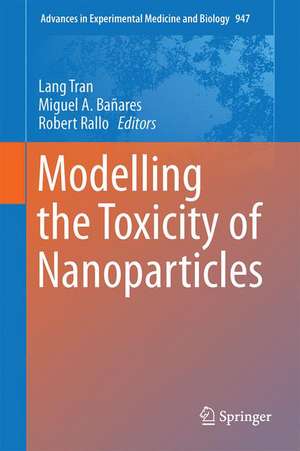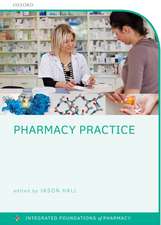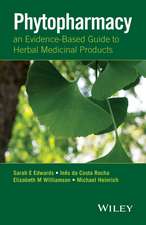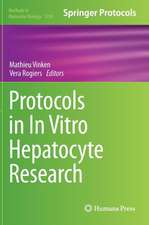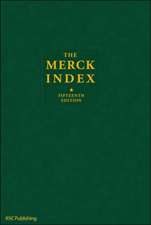Modelling the Toxicity of Nanoparticles: Advances in Experimental Medicine and Biology, cartea 947
Editat de Lang Tran, Miguel A. Bañares, Robert Ralloen Limba Engleză Hardback – 15 feb 2017
Through contributions by academic, industrial, and governmental experts, Modelling the Toxicity of Nanoparticles delivers clear instruction on these methods and their integration and use in risk assessment. Specific topics include the physico-chemical characteristics of engineered nanoparticles, nanoparticle interactions, in vivo nanoparticle processing, and more.
A much-needed practical guide, Modelling the Toxicity of Nanoparticles is a key text for researchers as well as government and industry regulators.
| Toate formatele și edițiile | Preț | Express |
|---|---|---|
| Paperback (1) | 962.15 lei 38-44 zile | |
| Springer International Publishing – 13 iul 2018 | 962.15 lei 38-44 zile | |
| Hardback (1) | 986.91 lei 38-44 zile | |
| Springer International Publishing – 15 feb 2017 | 986.91 lei 38-44 zile |
Din seria Advances in Experimental Medicine and Biology
- 9%
 Preț: 719.56 lei
Preț: 719.56 lei - 5%
 Preț: 1095.03 lei
Preț: 1095.03 lei - 20%
 Preț: 691.93 lei
Preț: 691.93 lei - 5%
 Preț: 704.94 lei
Preț: 704.94 lei - 5%
 Preț: 704.94 lei
Preț: 704.94 lei - 5%
 Preț: 703.32 lei
Preț: 703.32 lei - 5%
 Preț: 704.22 lei
Preț: 704.22 lei - 5%
 Preț: 239.86 lei
Preț: 239.86 lei -
 Preț: 642.95 lei
Preț: 642.95 lei - 5%
 Preț: 820.42 lei
Preț: 820.42 lei - 5%
 Preț: 703.67 lei
Preț: 703.67 lei - 15%
 Preț: 629.45 lei
Preț: 629.45 lei - 15%
 Preț: 630.60 lei
Preț: 630.60 lei - 5%
 Preț: 1013.60 lei
Preț: 1013.60 lei - 5%
 Preț: 704.22 lei
Preț: 704.22 lei - 5%
 Preț: 705.14 lei
Preț: 705.14 lei - 20%
 Preț: 1142.10 lei
Preț: 1142.10 lei - 5%
 Preț: 1150.76 lei
Preț: 1150.76 lei - 18%
 Preț: 1100.97 lei
Preț: 1100.97 lei - 5%
 Preț: 1266.72 lei
Preț: 1266.72 lei - 5%
 Preț: 1145.01 lei
Preț: 1145.01 lei - 5%
 Preț: 1083.16 lei
Preț: 1083.16 lei - 18%
 Preț: 1104.69 lei
Preț: 1104.69 lei - 5%
 Preț: 1411.39 lei
Preț: 1411.39 lei - 20%
 Preț: 1026.46 lei
Preț: 1026.46 lei - 18%
 Preț: 930.42 lei
Preț: 930.42 lei - 5%
 Preț: 292.57 lei
Preț: 292.57 lei - 18%
 Preț: 941.47 lei
Preț: 941.47 lei - 18%
 Preț: 1214.88 lei
Preț: 1214.88 lei - 5%
 Preț: 1210.77 lei
Preț: 1210.77 lei - 5%
 Preț: 1270.49 lei
Preț: 1270.49 lei - 5%
 Preț: 1083.51 lei
Preț: 1083.51 lei - 18%
 Preț: 1113.70 lei
Preț: 1113.70 lei - 5%
 Preț: 1145.52 lei
Preț: 1145.52 lei - 5%
 Preț: 1394.53 lei
Preț: 1394.53 lei - 5%
 Preț: 1283.60 lei
Preț: 1283.60 lei - 18%
 Preț: 1393.77 lei
Preț: 1393.77 lei - 18%
 Preț: 1402.55 lei
Preț: 1402.55 lei - 24%
 Preț: 806.15 lei
Preț: 806.15 lei - 18%
 Preț: 1222.29 lei
Preț: 1222.29 lei - 5%
 Preț: 1405.29 lei
Preț: 1405.29 lei - 5%
 Preț: 1591.34 lei
Preț: 1591.34 lei - 5%
 Preț: 1283.09 lei
Preț: 1283.09 lei - 18%
 Preț: 1105.93 lei
Preț: 1105.93 lei - 5%
 Preț: 1079.03 lei
Preț: 1079.03 lei - 15%
 Preț: 638.91 lei
Preț: 638.91 lei - 5%
 Preț: 1079.03 lei
Preț: 1079.03 lei - 18%
 Preț: 929.84 lei
Preț: 929.84 lei
Preț: 986.91 lei
Preț vechi: 1038.85 lei
-5% Nou
Puncte Express: 1480
Preț estimativ în valută:
188.93€ • 194.31$ • 156.74£
188.93€ • 194.31$ • 156.74£
Carte tipărită la comandă
Livrare economică 14-20 februarie
Preluare comenzi: 021 569.72.76
Specificații
ISBN-13: 9783319477527
ISBN-10: 3319477528
Pagini: 605
Ilustrații: XVII, 352 p. 102 illus., 83 illus. in color.
Dimensiuni: 155 x 235 x 26 mm
Greutate: 0.84 kg
Ediția:1st ed. 2017
Editura: Springer International Publishing
Colecția Springer
Seria Advances in Experimental Medicine and Biology
Locul publicării:Cham, Switzerland
ISBN-10: 3319477528
Pagini: 605
Ilustrații: XVII, 352 p. 102 illus., 83 illus. in color.
Dimensiuni: 155 x 235 x 26 mm
Greutate: 0.84 kg
Ediția:1st ed. 2017
Editura: Springer International Publishing
Colecția Springer
Seria Advances in Experimental Medicine and Biology
Locul publicării:Cham, Switzerland
Cuprins
Engineered Nanoparticles – Their physico-chemical characteristics and how to measure them.- Measurement .- The Life-Cycle of Engineered Nanoparticles.- From Dose to Response – In vivo Nanoparticle Processing and Potential Toxicity.- From Dose to Response – Literature review od (Q)SAR Modelling of Nanomaterial Toxicity.- Systems biology to support nanomaterial grouping.- Multiscale modelling of bionano interface.- Biological Surface Adsorption Index of Nanomaterials - Modeling Surface Interactions of Nanomaterials with Biomolecules.- Case study I - An integrated data-driven strategy for safe-by-design nanoparticles: The FP7 MODERN Project.- Case study II - Compilation of Data and Modeling of Nanoparticle Interactions and Toxicity and in the European NanoPUZZLES Project.- Case study III – The construction of a nanotoxicity database: the MOD-ENP-TOX experience.
Notă biografică
Dr Lang Tran is the Principal Toxicologist at the Institute of Occupational Medicine. Lang has contributed considerably on the toxicology of inhaled particles and fibres. His early work was in the mathematical modelling of the retention and clearance of man-made mineral fibres and mineral dusts. He has led the investigation and the risk assessment of inhaled poorly soluble particles which helped NIOSH in establishing the control limit for fine and ultrafine TiO2 aerosol.
From his experience with particle toxicology Lang has contributed also in many European Research Projects through the Framework 6 and 7 Programmes. Most notable are the project FP7 ENPRA (Risk Assessment of Engineered Nanoparticles) and FP7 MARINA (Managing Risks of Nanoparticles). Lang is currently the chairman of the COST Action TD1204 MODENA on Modelling the toxicity of nanoparticles. Lang is an editor of the NANOTOXICOLOGY and PARTICLE and FIBRE TOXICOLOGY journals. He also contributesin the organisation of the NANOTOXICOLOGY Symposium series.He has been Deputy Vice-President of CSIC, Spanish National Research Council (2014-2015), chairman of the Management Committee of COST Action D36 (Molecular structure-performance relationships at the surface of functional materials), 2006-2011 and is Vice-Chairman of the Management Committee of COST Action TD1404 MODENA (Modeling Nanomaterial Toxicity), on toxicity of nanoparticles (2012-2016). He is co-founder of Advanced Dispersed Particles in 2011, a CSIC spin-off company, in 2011
Bañares research focuses on understanding structure-property relationships at a molecular scale at the surface of functional materials for catalysis and toxicity by combining in situ and operando analyses with computational description of the structure, spectra and reactivity of functional materials. He has more than 190 publications in international journals and an “h” factor or 37 with more than 27 plenary/keynote lectures. Bañares research stands on the use of real-time Raman spectroscopy during catalysis combining in situ spectroscopic characterization of functional materials with simultaneous performance measurement. He coined the term “operando” to identify this advanced in situ spectroscopy.
Dr. Robert Rallo, Associate Professor of Computer Science and Artificial Intelligence in the Departament d’Enginyeria Informàtica i Matemàtiques at Universitat Rovira i Virgili, Tarragona, Catalunya. He directs the Research Group on Bioinformatics & Computational Engineering (BIOCENIT, www.biocenit.cat) and is also the Director of the Advanced Technology Innovation Center (ATIC) at the Universitat Rovira i Virgili. In 2007 and 2009 he was a visiting professor at the University of California Los Angeles where he is also faculty member of the Center for Environmental Implications of Nanotechnology. Since 2013 he serves as Chair for the Modeling WG in the EU NanoSafety Cluster. From 2013 to 2015 he was the EU co-chair of the US-EU Nano-Dialogue Community of Research on Predictive Modeling and Human Health. His research focuses on multi-scale modeling of complex systems of industrial or environmental relevance. Dr. Rallo serves regularly as reviewer for high-ranked scientific journals and international research organizations.
Textul de pe ultima copertă
In today’s nanotechnology and pharmaceutical research, alternative toxicology testing methods are crucial for ethically and commercially sound practice. This book provides practical guidelines on how to develop and validate quantitative nanostructure-toxicity relationship (QNTR) models, which are ideal for rapidly exploring the effects of a large number of variables in complex scenarios.
Through contributions by academic, industrial, and governmental experts, Modelling the Toxicity of Nanoparticles delivers clear instruction on these methods and their integration and use in risk assessment. Specific topics include the physico-chemical characteristics of engineered nanoparticles, nanoparticle interactions, in vivo nanoparticle processing, and more.
A much-needed practical guide, Modelling the Toxicity of Nanoparticles is a key text for researchers as well as government and industry regulators.
Through contributions by academic, industrial, and governmental experts, Modelling the Toxicity of Nanoparticles delivers clear instruction on these methods and their integration and use in risk assessment. Specific topics include the physico-chemical characteristics of engineered nanoparticles, nanoparticle interactions, in vivo nanoparticle processing, and more.
A much-needed practical guide, Modelling the Toxicity of Nanoparticles is a key text for researchers as well as government and industry regulators.
Caracteristici
Summarizes state-of-the art exposure and hazard assessment of engineered nanomaterials Describes in clear terms quantitative nanostructure-toxicity relationship (QNTR) models Provides essential guidance for both regulators and researchers
